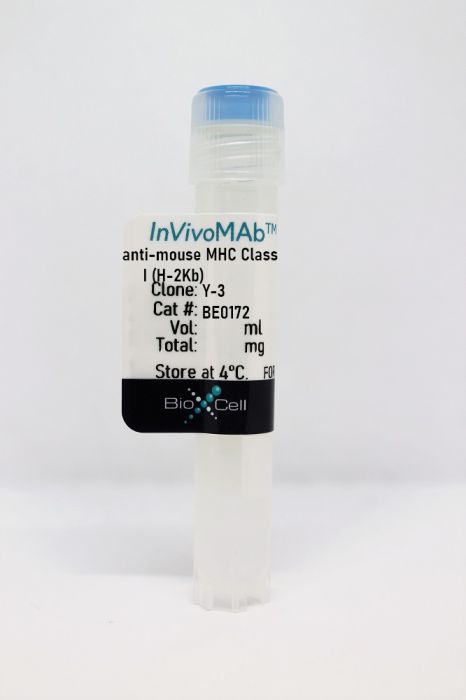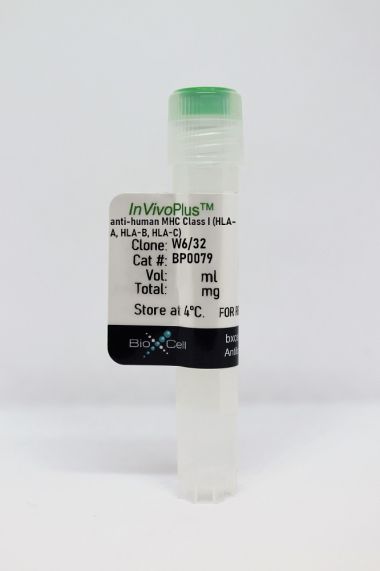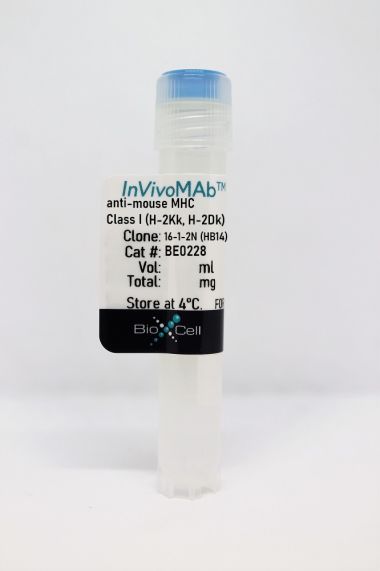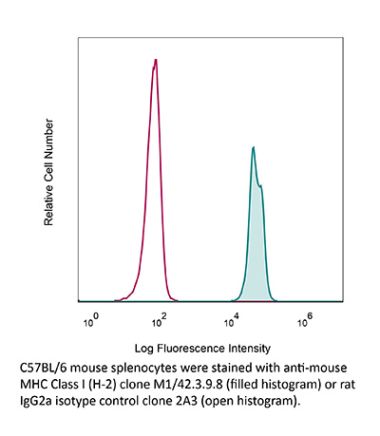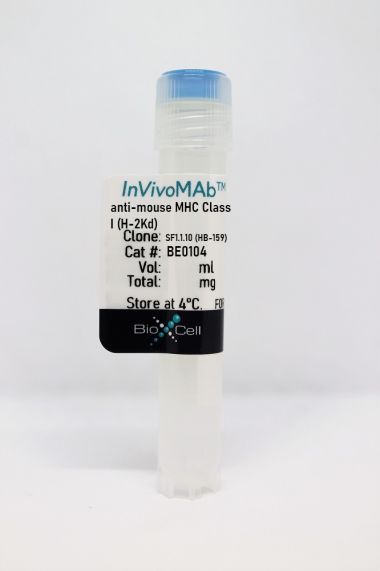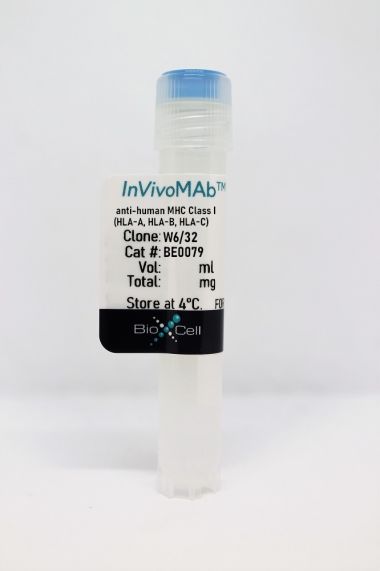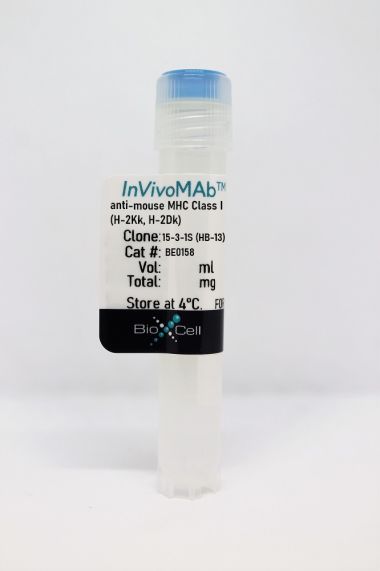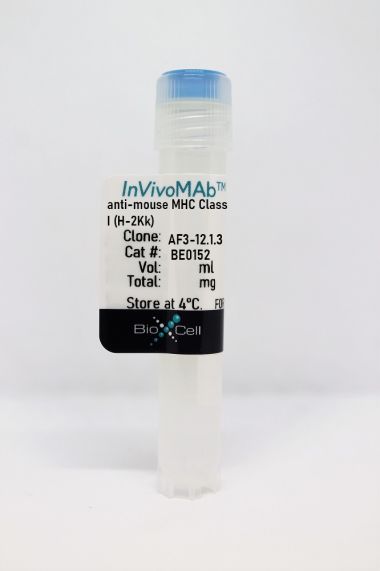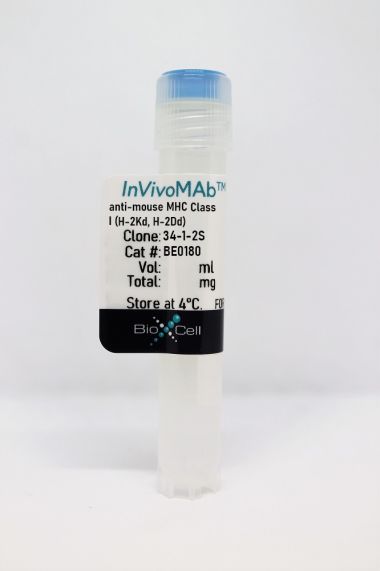InVivoMAb anti-mouse MHC Class I (H-2Kb)
Product Details
The Y-3 monoclonal antibody is reported to react with the mouse H-2Kb, H-2Kk, H-2Kq, H-2Kr, H-2ksand not H-2Kd MHC class I alloantigens. MHC class I antigens are heterodimers consisting of one alpha chain (44 kDa) associated with β2 microglobulin (11.5 kDa). The antigen is expressed by all nucleated cells at varying levels. MHC Class I molecules present endogenously synthesized antigenic peptides to CD8 T cells.Specifications
| Isotype | Mouse IgG2b, κ |
|---|---|
| Recommended Isotype Control(s) | InVivoMAb mouse IgG2b isotype control, unknown specificity |
| Recommended Dilution Buffer | InVivoPure pH 7.0 Dilution Buffer |
| Conjugation | This product is unconjugated. Conjugation is available via our Antibody Conjugation Services. |
| Immunogen | Con A stimulated spleen cells from BALB.B mice |
| Reported Applications |
in vivo MHC II blockade Functional assays Purification of MHC peptide complexes Flow cytometry |
| Formulation |
PBS, pH 7.0 Contains no stabilizers or preservatives |
| Endotoxin |
<2EU/mg (<0.002EU/μg) Determined by LAL gel clotting assay |
| Purity |
>95% Determined by SDS-PAGE |
| Sterility | 0.2 µm filtration |
| Production | Purified from cell culture supernatant in an animal-free facility |
| Purification | Protein G |
| RRID | AB_10949300 |
| Molecular Weight | 150 kDa |
| Storage | The antibody solution should be stored at the stock concentration at 4°C. Do not freeze. |
Recommended Products
in vivo MHC II blockade
Baptista, A. P., et al. (2019). "The Chemoattractant Receptor Ebi2 Drives Intranodal Naive CD4(+) T Cell Peripheralization to Promote Effective Adaptive Immunity" Immunity 50(5): 1188-1201.e1186. PubMed
Lymph nodes (LNs) play critical roles in adaptive immunity by concentrating in one location the antigens, antigen-presenting cells, and antigen-responsive lymphocytes involved in such responses. Recent studies have revealed nonrandom localization of innate and adaptive immune cells within these organs, suggesting that microanatomical positioning optimizes responses involving sparse cooperating cells. Here, we report that the peripheral localization of LN cDC2 dendritic cells specialized for MHC-II antigen presentation is matched by a similarly biased paracortical distribution of CD4(+) T cells directed by the chemoattractant receptor Ebi2. In the absence of Ebi2, CD4(+) T cells lose their location bias and are delayed in antigen recognition, proliferative expansion, differentiation, direct effector activity, and provision of help for CD8(+) T cell-mediated memory responses, limiting host defense and vaccine responses. These findings demonstrate evolutionary selection for distinct niches within the LN that promote cellular responses, emphasizing the critical link between fine-grained tissue organization and host defense.
Flow Cytometry
Reed, B. K., et al. (2015). "A Versatile Simple Capture Assay for Assessing the Structural Integrity of MHC Multimer Reagents" PLoS One 10(9): e0137984. PubMed
Antigen-specific T cell responses can be visualized using MHC:peptide multimers. In cases where robust T cell controls are not readily available to assess the integrity of multimer reagents prior to analyzing limited sample, the ability to assess the structural integrity of MHC multimers before their use in critical experiments would be useful. We present a method to probe the structural integrity of MHC multimers using antibodies specific for conformational determinants. Beads coated with anti-mouse Ig are incubated with conformation-specific mouse monoclonal antibody and then with fluorescently tagged MHC multimer. The ability of the bead to capture the labeled multimer can be measured semi-quantitatively by flow cytometry. In this manner, the correct folding of MHC multimers can be visualized and batches of multimer can be compared for quality control. Because there are multiple conformational epitopes formed by various molecular interactions among heavy chain, peptide, and beta2M, this capture assay can assess the fidelity of each aspect of multimer structure, depending on the availability of antibodies. The described approach could be particularly useful for studies using irreplaceable samples, including patient samples collected in clinical trials.
Flow Cytometry
Zanker, D., et al. (2015). "T cells recognizing a 11mer influenza peptide complexed to H-2D(b) show promiscuity for peptide length" Immunol Cell Biol 93(5): 500-507. PubMed
T-cell repertoire is selected according to self peptide-MHC (major histocompatibility complex) complexes in the thymus. Although most peripheral T cells recognize specific pathogen-derived peptides complexed to self-MHC exclusively, some possess cross-reactivity to other self or foreign peptides presented by self-MHC molecules; a phenomenon often termed T-cell receptor (TCR) promiscuity or degeneracy. TCR promiscuity has been attributed to various autoimmune conditions. On the other hand, it is considered a mechanism for a relatively limited TCR repertoire to deal with a potentially much larger antigenic peptide repertoire. Such property has also been utilized to bypass self-tolerance for cancer vaccine development. Although many studies explored such degeneracy for peptide of the same length, few studies reported such properties for peptides of different length. In this study, we finely characterized the CD8(+) T-cell response specific for a 11mer peptide derived from influenza A viral polymerase basic protein 2. The short-term T-cell line, despite possessing highly biased TCR, was able to react with multiple peptides of different length sharing the same core sequence. Out data clearly showed the importance of detailed and quantitative assessments for such T-cell specificity. Our data also emphasize the importance of biochemical demonstration of the naturally presented minimal peptide.
Purification of MHC peptide complexes
Trujillo, J. A., et al. (2014). "Structural and functional correlates of enhanced antiviral immunity generated by heteroclitic CD8 T cell epitopes" J Immunol 192(11): 5245-5256. PubMed
Peptides that bind poorly to MHC class I molecules often elicit low-functional avidity T cell responses. Peptide modification by altering the anchor residue facilitates increased binding affinity and may elicit T cells with increased functional avidity toward the native epitope (“heteroclitic”). This augmented MHC binding is likely to increase the half-life and surface density of the heteroclitic complex, but precisely how this enhanced T cell response occurs in vivo is not known. Furthermore, the ideal heteroclitic epitope will elicit T cell responses that completely cross-react with the native epitope, maximizing protection and minimizing undesirable off-target effects. Such epitopes have been difficult to identify. In this study, using mice infected with a murine coronavirus that encodes epitopes that elicit high (S510, CSLWNGPHL)- and low (S598, RCQIFANI)-functional avidity responses, we show that increased expression of peptide S598 but not S510 generated T cells with enhanced functional avidity. Thus, immune responses can be augmented toward T cell epitopes with low functional avidity by increasing Ag density. We also identified a heteroclitic epitope (RCVIFANI) that elicited a T cell response with nearly complete cross-reactivity with native epitope and demonstrated increased MHC/peptide abundance compared with native S598. Structural and thermal melt analyses indicated that the Q600V substitution enhanced stability of the peptide/MHC complex without greatly altering the antigenic surface, resulting in highly cross-reactive T cell responses. Our data highlight that increased peptide/MHC complex display contributes to heteroclitic epitope efficacy and describe parameters for maximizing immune responses that cross-react with the native epitope.
Functional Assays
Bose, T. O., et al. (2013). "CD11a regulates effector CD8 T cell differentiation and central memory development in response to infection with Listeria monocytogenes" Infect Immun 81(4): 1140-1151. PubMed
beta2 (CD18) integrins with alpha-chains CD11a, -b, -c, and -d are important adhesion molecules necessary for leukocyte migration and cellular interactions. CD18 deficiency leads to recurrent bacterial infections and poor wound healing due to reduced migration of leukocytes to inflammatory sites. CD8 T cells also upregulate CD11a, CD11b, and CD11c upon activation. However, the role these molecules play for CD8 T cells in vivo is not known. To determine the function of individual beta2 integrins, we examined CD8 T cell responses to Listeria monocytogenes infection in CD11a-, CD11b-, and CD11c-deficient mice. The absence of CD11b or CD11c had no effect on the generation of antigen-specific CD8 T cells. In contrast, the magnitude of the primary CD8 T cell response in CD11a-deficient mice was significantly reduced. Moreover, the response in CD11a(-/-) mice exhibited reduced differentiation of short-lived effector cells (KLRG1(hi) CD127(lo)), although cytokine and granzyme B production levels were unaffected. Notably, CD11a deficiency resulted in greatly enhanced generation of CD62L(+) central memory cells. Surprisingly, CD8 T cells lacking CD11a mounted a robust secondary response to infection. Taken together, these findings demonstrated that CD11a expression contributes to expansion and differentiation of primary CD8 T cells but may be dispensable for secondary responses to infection.
Purification of MHC peptide complexes, Flow Cytometry
Croft, N. P., et al. (2013). "Kinetics of antigen expression and epitope presentation during virus infection" PLoS Pathog 9(1): e1003129. PubMed
Current knowledge about the dynamics of antigen presentation to T cells during viral infection is very poor despite being of fundamental importance to our understanding of anti-viral immunity. Here we use an advanced mass spectrometry method to simultaneously quantify the presentation of eight vaccinia virus peptide-MHC complexes (epitopes) on infected cells and the amounts of their source antigens at multiple times after infection. The results show a startling 1000-fold range in abundance as well as strikingly different kinetics across the epitopes monitored. The tight correlation between onset of protein expression and epitope display for most antigens provides the strongest support to date that antigen presentation is largely linked to translation and not later degradation of antigens. Finally, we show a complete disconnect between the epitope abundance and immunodominance hierarchy of these eight epitopes. This study highlights the complexity of viral antigen presentation by the host and demonstrates the weakness of simple models that assume total protein levels are directly linked to epitope presentation and immunogenicity.
Functional Assays
Hammerling, G. J., et al. (1982). "Localization of allodeterminants on H-2Kb antigens determined with monoclonal antibodies and H-2 mutant mice" Proc Natl Acad Sci U S A 79(15): 4737-4741. PubMed
The topographic arrangement of antigenic determinants on the H-2Kb molecule was investigated by antibody competition studies with a series of monoclonal anti-Kb antibodies. For identification of amino acid residues participating in formation of allodeterminants H-2Kb mutant mice with defined amino acid substitutions were analyzed. The determinants were found to be located in at least two spatially separate clusters on the H-2Kb molecule. Determinants of one cluster are affected by mutations at amino acid positions 155 and 156, whereas determinants of a second cluster are modified by amino acid substitutions at positions 77 and 89. For a third cluster of determinants no relevant amino acid positions could be identified, but competition data indicate that this cluster is adjacent to the second one. The data suggest that the first two domains of H-2 antigens carry most allodeterminants.
- Immunology and Microbiology,
- Cancer Research,
- Mus musculus (House mouse)
PAF1c links S-phase progression to immune evasion and MYC function in pancreatic carcinoma.
In Nature Communications on 16 February 2024 by Gaballa, A., Gebhardt-Wolf, A., et al.
PubMed
In pancreatic ductal adenocarcinoma (PDAC), endogenous MYC is required for S-phase progression and escape from immune surveillance. Here we show that MYC in PDAC cells is needed for the recruitment of the PAF1c transcription elongation complex to RNA polymerase and that depletion of CTR9, a PAF1c subunit, enables long-term survival of PDAC-bearing mice. PAF1c is largely dispensable for normal proliferation and regulation of MYC target genes. Instead, PAF1c limits DNA damage associated with S-phase progression by being essential for the expression of long genes involved in replication and DNA repair. Surprisingly, the survival benefit conferred by CTR9 depletion is not due to DNA damage, but to T-cell activation and restoration of immune surveillance. This is because CTR9 depletion releases RNA polymerase and elongation factors from the body of long genes and promotes the transcription of short genes, including MHC class I genes. The data argue that functionally distinct gene sets compete for elongation factors and directly link MYC-driven S-phase progression to tumor immune evasion. © 2024. The Author(s).
- Immunology and Microbiology
Interventional hydrogel microsphere vaccine as an immune amplifier for activated antitumour immunity after ablation therapy.
In Nature Communications on 11 July 2023 by Liu, X., Zhuang, Y., et al.
PubMed
The response rate of pancreatic cancer to chemotherapy or immunotherapy pancreatic cancer is low. Although minimally invasive irreversible electroporation (IRE) ablation is a promising option for irresectable pancreatic cancers, the immunosuppressive tumour microenvironment that characterizes this tumour type enables tumour recurrence. Thus, strengthening endogenous adaptive antitumour immunity is critical for improving the outcome of ablation therapy and post-ablation immune therapy. Here we present a hydrogel microsphere vaccine that amplifies post-ablation anti-cancer immune response via releasing its cargo of FLT3L and CD40L at the relatively lower pH of the tumour bed. The vaccine facilitates migration of the tumour-resident type 1 conventional dendritic cells (cDC1) to the tumour-draining lymph nodes (TdLN), thus initiating the cDC1-mediated antigen cross-presentation cascade, resulting in enhanced endogenous CD8+ T cell response. We show in an orthotopic pancreatic cancer model in male mice that the hydrogel microsphere vaccine transforms the immunologically cold tumour microenvironment into hot in a safe and efficient manner, thus significantly increasing survival and inhibiting the growth of distant metastases. © 2023. The Author(s).
- Cancer Research,
- Genetics,
- Immunology and Microbiology
Pharmacologic modulation of RNA splicing enhances anti-tumor immunity.
In Cell on 22 July 2021 by Lu, S. X., De Neef, E., et al.
PubMed
Although mutations in DNA are the best-studied source of neoantigens that determine response to immune checkpoint blockade, alterations in RNA splicing within cancer cells could similarly result in neoepitope production. However, the endogenous antigenicity and clinical potential of such splicing-derived epitopes have not been tested. Here, we demonstrate that pharmacologic modulation of splicing via specific drug classes generates bona fide neoantigens and elicits anti-tumor immunity, augmenting checkpoint immunotherapy. Splicing modulation inhibited tumor growth and enhanced checkpoint blockade in a manner dependent on host T cells and peptides presented on tumor MHC class I. Splicing modulation induced stereotyped splicing changes across tumor types, altering the MHC I-bound immunopeptidome to yield splicing-derived neoepitopes that trigger an anti-tumor T cell response in vivo. These data definitively identify splicing modulation as an untapped source of immunogenic peptides and provide a means to enhance response to checkpoint blockade that is readily translatable to the clinic. Copyright © 2021 Elsevier Inc. All rights reserved.
- Immunology and Microbiology
Immunopeptidomics for Dummies: Detailed Experimental Protocols and Rapid, User-Friendly Visualization of MHC I and II Ligand Datasets with MhcVizPipe
Preprint on BioRxiv : the Preprint Server for Biology on 3 November 2020 by Kovalchik, K. A., Wessling, L., et al.
PubMed
h4>ABSTRACT/h4> Immunopeptidomics refers to the science of investigating the composition and dynamics of peptides presented by major histocompatibility complex (MHC) class I and class II molecules using mass spectrometry (MS). Here, we aim to provide a technical report to any non-expert in the field wishing to establish and/or optimize an immunopeptidomic workflow with relatively limited computational knowledge and resources. To this end, we thoroughly describe step-by-step instructions to isolate MHC class I and II-associated peptides from various biological sources, including mouse and human biospecimens. Most notably, we created MhcVizPipe (MVP) ( https://github.com/CaronLab/MhcVizPipe ), a new and easy-to-use open-source software tool to rapidly assess the quality and the specific enrichment of immunopeptidomic datasets upon the establishment of new workflows. In fact, MVP enables intuitive visualization of multiple immunopeptidomic datasets upon testing sample preparation protocols and new antibodies for the isolation of MHC class I and II peptides. In addition, MVP enables the identification of unexpected binding motifs and facilitates the analysis of non-canonical MHC peptides. We anticipate that the experimental and bioinformatic resources provided herein will represent a great starting point for any non-expert and will therefore foster the accessibility and expansion of the field to ultimately boost its maturity and impact.
- FC/FACS,
- Radio,
- Mus musculus (House mouse),
- Immunology and Microbiology
An input-controlled model system for identification of MHC bound peptides enabling laboratory comparisons of immunopeptidome experiments.
In Journal of Proteomics on 30 September 2020 by Klatt, M. G., Aretz, Z. E. H., et al.
PubMed
Characterization of MHC-bound peptides by mass spectrometry (MS) is an essential technique for immunologic studies. Many efforts have been made to quantify the number of MHC-presented ligands by MS and to define the limits of detection of a specific MHC ligand. However, these experiments are often complex and comparisons across different laboratories are challenging. Therefore, we compared and orthogonally validated quantitation of peptide:MHC complexes by radioimmunoassay and flow cytometry using TCR mimic antibodies in three model systems to establish a method to control the experimental input of peptide MHC:complexes for MS analysis. Following isolation of MHC-bound peptides we identified and quantified an MHC ligand of interest with high correlation to the initial input. We found that the diversity of the presented ligandome, as well as the peptide sequence itself affected the detection of the target peptide. Furthermore, results were applicable from these model systems to unmodified cell lines with a tight correlation between HLA-A*02 complex input and the number of identified HLA-A*02 ligands. Overall, this framework provides an easily accessible experimental setup that offers the opportunity to control the peptide:MHC input and in this way compare immunopeptidome experiments not only within but also between laboratories, independent of their experimental approach. SIGNIFICANCE: Although immunopeptidomics is an essential tool for the characterization of MHCbound peptides on the cell surface, there are no easily applicable established protocols available that allow comparison of immunopeptidome experiments across laboratories. Here, we demonstrate that controlling the peptide:MHC input for immunopurification and LC-MS/MS experiments by flow cytometry in pre-defined model systems allows the generation of qualitative and quantitative data that can easily be compared between investigators, independently of their methods for MHC ligand isolation for MS. Copyright © 2020 Elsevier B.V. All rights reserved.
- In Vivo,
- Mus musculus (House mouse),
- Immunology and Microbiology
The Chemoattractant Receptor Ebi2 Drives Intranodal Naive CD4+ T Cell Peripheralization to Promote Effective Adaptive Immunity.
In Immunity on 21 May 2019 by Baptista, A. P., Gola, A., et al.
PubMed
Lymph nodes (LNs) play critical roles in adaptive immunity by concentrating in one location the antigens, antigen-presenting cells, and antigen-responsive lymphocytes involved in such responses. Recent studies have revealed nonrandom localization of innate and adaptive immune cells within these organs, suggesting that microanatomical positioning optimizes responses involving sparse cooperating cells. Here, we report that the peripheral localization of LN cDC2 dendritic cells specialized for MHC-II antigen presentation is matched by a similarly biased paracortical distribution of CD4+ T cells directed by the chemoattractant receptor Ebi2. In the absence of Ebi2, CD4+ T cells lose their location bias and are delayed in antigen recognition, proliferative expansion, differentiation, direct effector activity, and provision of help for CD8+ T cell-mediated memory responses, limiting host defense and vaccine responses. These findings demonstrate evolutionary selection for distinct niches within the LN that promote cellular responses, emphasizing the critical link between fine-grained tissue organization and host defense.Published by Elsevier Inc.
An obligatory role for club cells in preventing obliterative bronchiolitis in lung transplants.
In JCI Insight on 16 April 2019 by Liu, Z., Liao, F., et al.
PubMed
Obliterative bronchiolitis (OB) is a poorly understood airway disease characterized by the generation of fibrotic bronchiolar occlusions. In the lung transplant setting, OB is a pathological manifestation of bronchiolitis obliterans syndrome (BOS), which is a major impediment to long-term recipient survival. Club cells play a key role in bronchiolar epithelial repair, but whether they promote lung transplant tolerance through preventing OB remains unclear. We determined if OB occurs in mouse orthotopic lung transplants following conditional transgene-targeted club cell depletion. In syngeneic lung transplants club cell depletion leads to transient epithelial injury followed by rapid club cell-mediated repair. In contrast, allogeneic lung transplants develop severe OB lesions and poorly regenerate club cells despite immunosuppression treatment. Lung allograft club cell ablation also triggers the recognition of alloantigens, and pulmonary restricted self-antigens reported associated with BOS development. However, CD8+ T cell depletion restores club cell reparative responses and prevents OB. In addition, ex-vivo analysis reveals a specific role for alloantigen-primed effector CD8+ T cells in preventing club cell proliferation and maintenance. Taken together, we demonstrate a vital role for club cells in maintaining lung transplant tolerance and propose a new model to identify the underlying mechanisms of OB.

